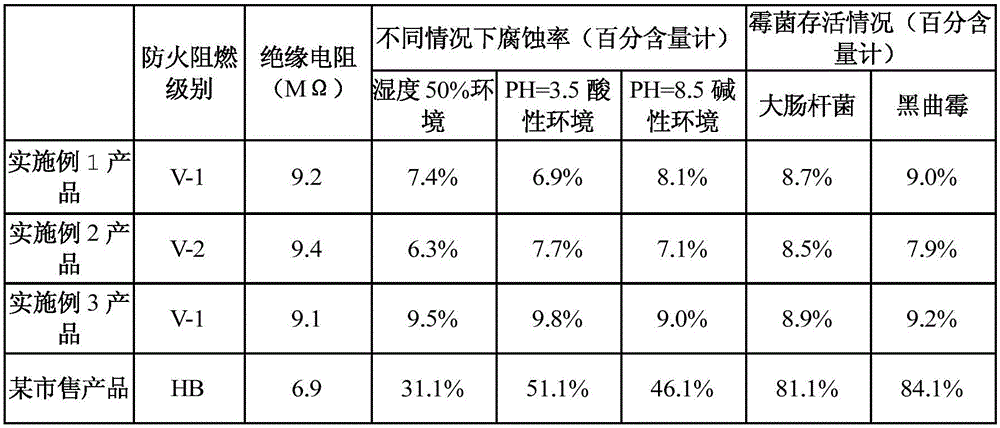Antimicrobial clothing fabric for children
A fabric and clothing technology, applied in the field of antibacterial children's clothing fabrics, can solve the problems of easy deformation and wrinkle, and achieve the effect of improving product performance and superior flame retardancy
- Summary
- Abstract
- Description
- Claims
- Application Information
AI Technical Summary
Problems solved by technology
Method used
Image
Examples
Embodiment 1
[0016] The antibacterial children's clothing fabric in this embodiment is bonded with a protective coating on the linen fabric, and the coating is composed of the following components in parts by mass: 24 parts of polyketone resin, 22 parts of α-olefin elastomer, polyacrylonitrile 22 parts of methyl acrylate, 20 parts of pure acrylic emulsion, 22 parts of argan oil, 22 parts of terpineol, 20 parts of amyl propionate, 22 parts of carbo resin, 22 parts of methyl p-hydroxybenzoate, sodium dehydroacetate 20 parts, 20 parts of zinc pyrithione, 20 parts of dodecyl ethoxy sulfobetaine, 22 parts of nano-silicon nitride powder, 20 parts of nano-carbon powder, 18 parts of nano-copper oxide, 22 parts of nylon fiber, glutinous rice 20 parts of powder, 18 parts of zinc borate powder, 20 parts of expanded vermiculite powder, 18 parts of barium metasulfate, 18 parts of polybenzimidazole imide, 18 parts of amidinourea phosphate, 16 parts of diethyl ethyl phosphonate, 12 parts of triisopropylp...
Embodiment 2
[0022] The antibacterial children's clothing fabric in this embodiment is bonded with a protective coating on the linen fabric, and the coating is composed of the following components in parts by mass: 26 parts of polyketone resin, 24 parts of α-olefin elastomer, polyacrylonitrile 24 parts of methyl acrylate, 22 parts of pure acrylic emulsion, 24 parts of argan oil, 24 parts of terpineol, 22 parts of amyl propionate, 24 parts of carbo resin, 24 parts of methyl p-hydroxybenzoate, sodium dehydroacetate 22 parts, 22 parts of zinc pyrithione, 22 parts of dodecyl ethoxy sulfobetaine, 24 parts of nano-silicon nitride powder, 22 parts of nano-carbon powder, 20 parts of nano-copper oxide, 24 parts of nylon fiber, glutinous rice 22 parts of powder, 20 parts of zinc borate powder, 22 parts of expanded vermiculite powder, 20 parts of barium metasulfate, 20 parts of polybenzimidazole imide, 20 parts of guanidinourea phosphate, 18 parts of diethyl ethyl phosphonate, 14 parts of triisopropy...
Embodiment 3
[0028] The antibacterial children's clothing fabric in this embodiment is bonded with a protective coating on the linen fabric, and the coating is composed of the following components in parts by mass: 28 parts of polyketone resin, 26 parts of α-olefin elastomer, polyacrylonitrile 26 parts of methyl acrylate, 24 parts of pure acrylic emulsion, 26 parts of argan oil, 26 parts of terpineol, 24 parts of amyl propionate, 26 parts of carbo resin, 26 parts of methyl p-hydroxybenzoate, sodium dehydroacetate 24 parts, 24 parts of zinc pyrithione, 24 parts of dodecyl ethoxy sulfobetaine, 26 parts of nano-silicon nitride powder, 24 parts of nano-carbon powder, 22 parts of nano-copper oxide, 26 parts of nylon fiber, glutinous rice 24 parts of powder, 22 parts of zinc borate powder, 24 parts of expanded vermiculite powder, 22 parts of barium metasulfate, 22 parts of polybenzimidazole imide, 22 parts of guaninourea phosphate, 20 parts of diethyl ethyl phosphonate, 16 parts of triisopropylp...
PUM
 Login to View More
Login to View More Abstract
Description
Claims
Application Information
 Login to View More
Login to View More - R&D
- Intellectual Property
- Life Sciences
- Materials
- Tech Scout
- Unparalleled Data Quality
- Higher Quality Content
- 60% Fewer Hallucinations
Browse by: Latest US Patents, China's latest patents, Technical Efficacy Thesaurus, Application Domain, Technology Topic, Popular Technical Reports.
© 2025 PatSnap. All rights reserved.Legal|Privacy policy|Modern Slavery Act Transparency Statement|Sitemap|About US| Contact US: help@patsnap.com

